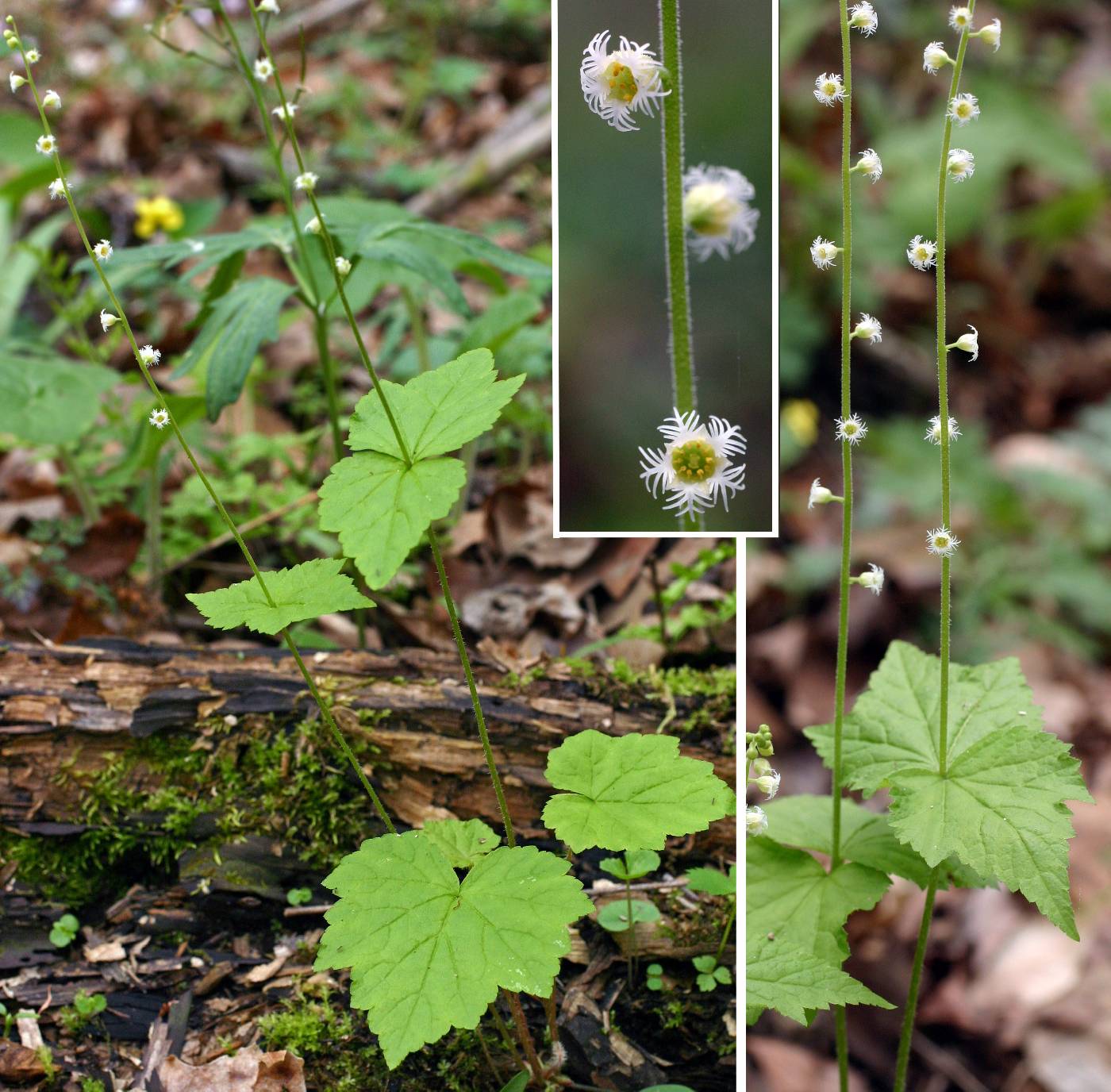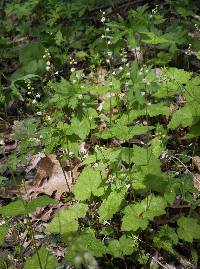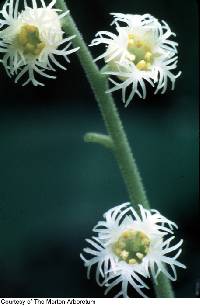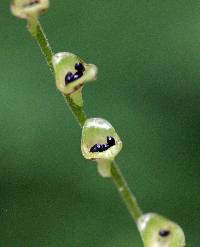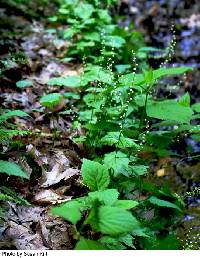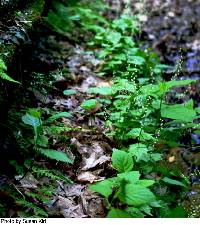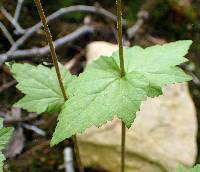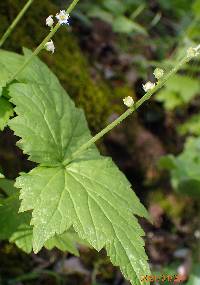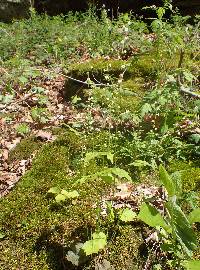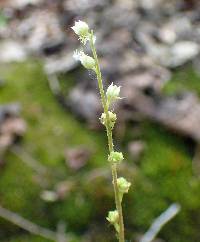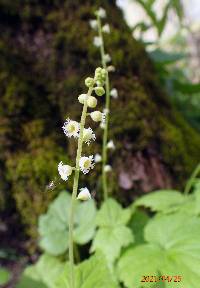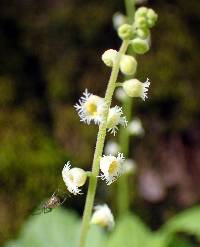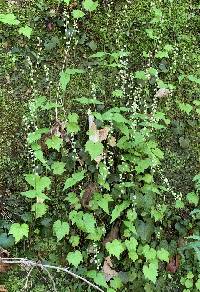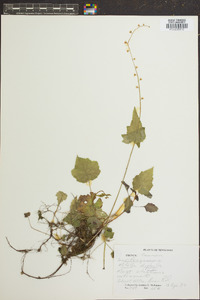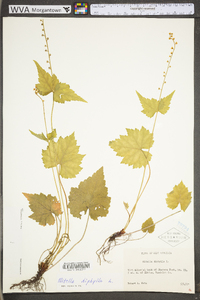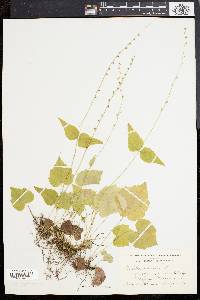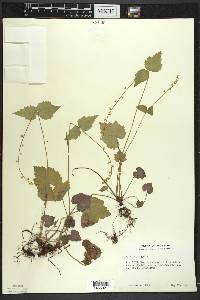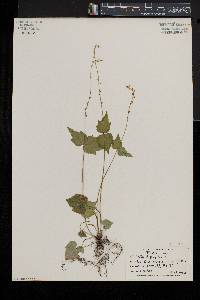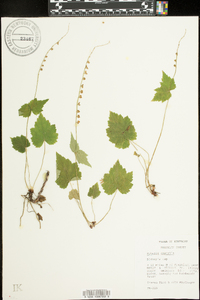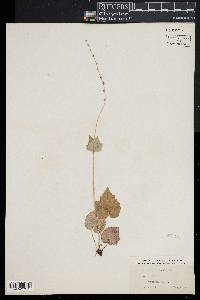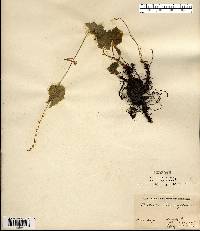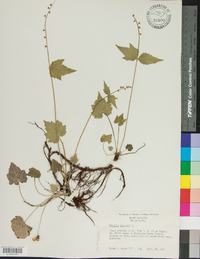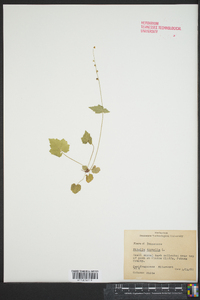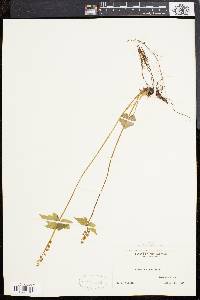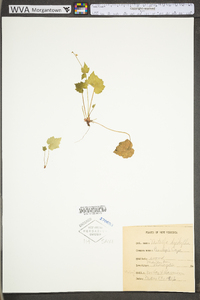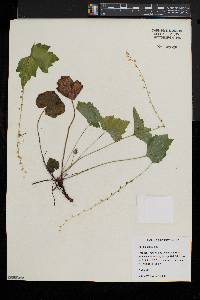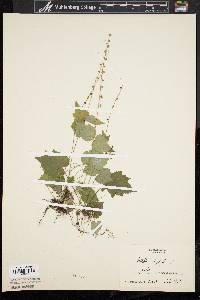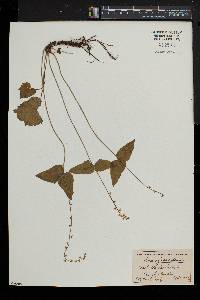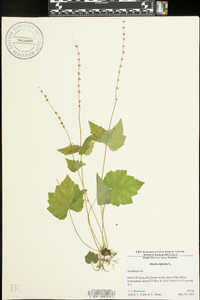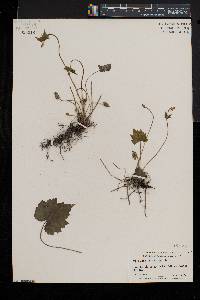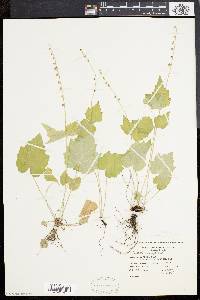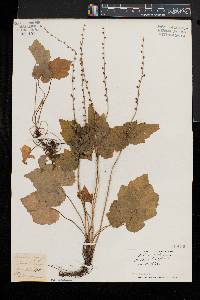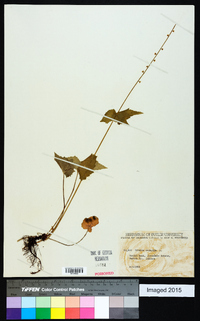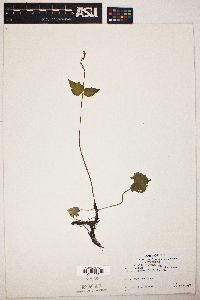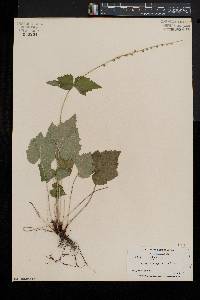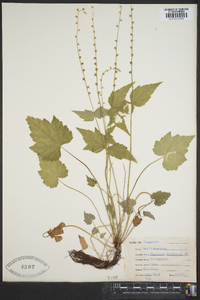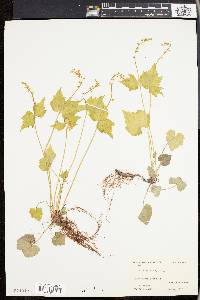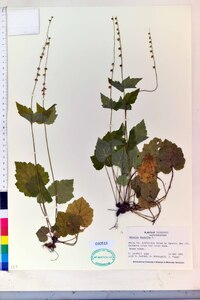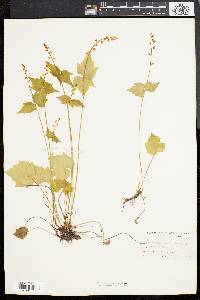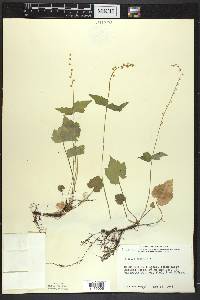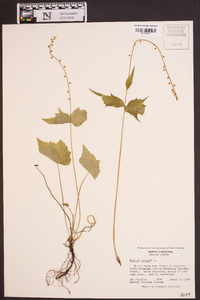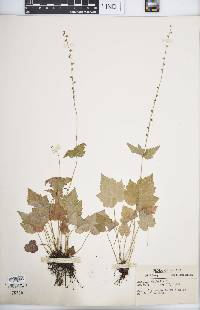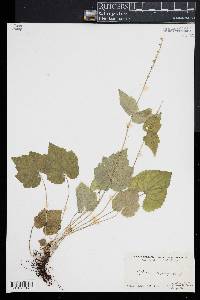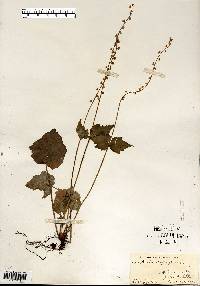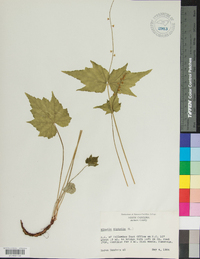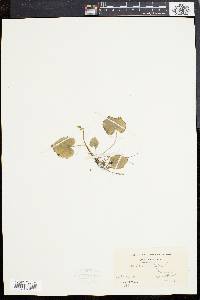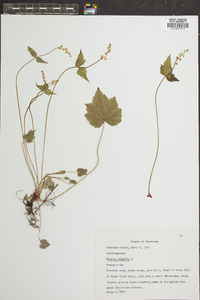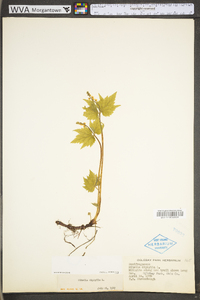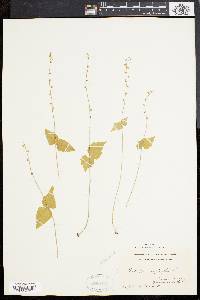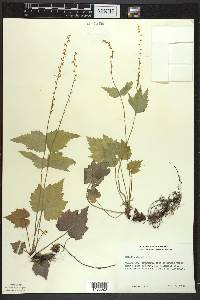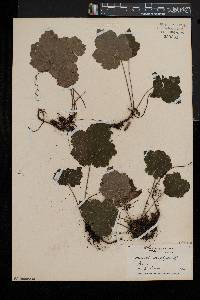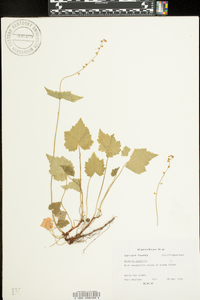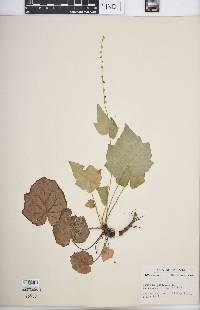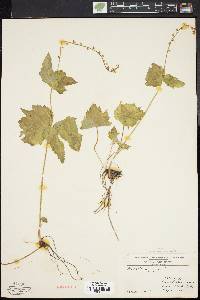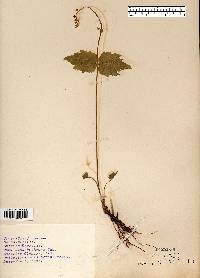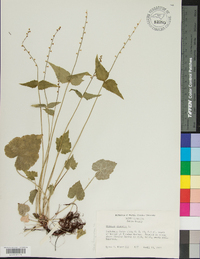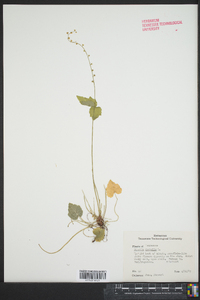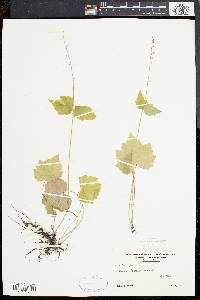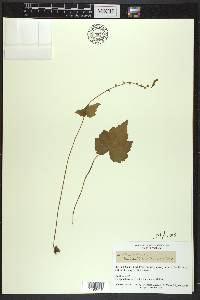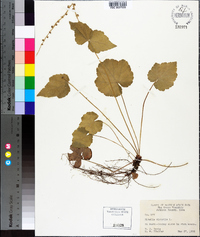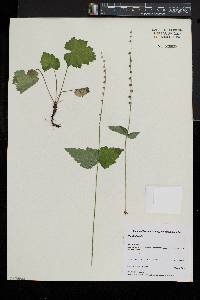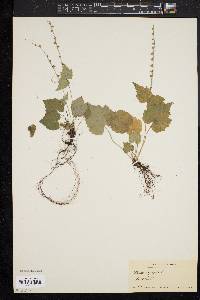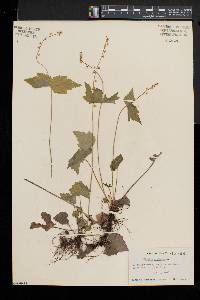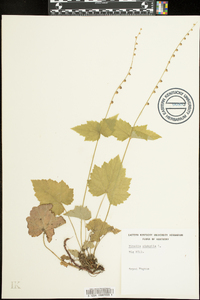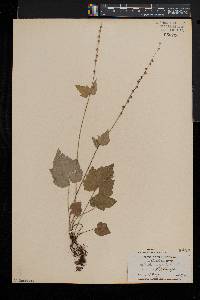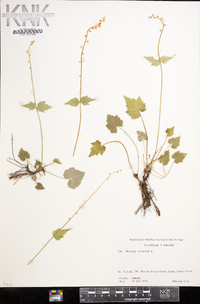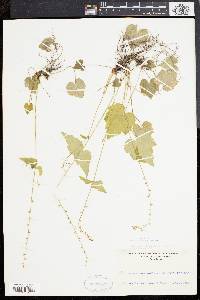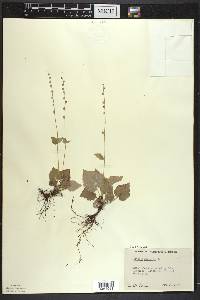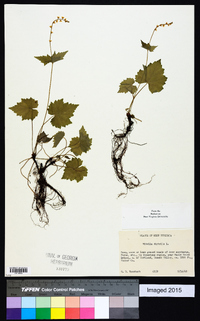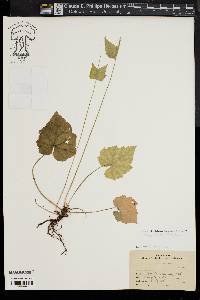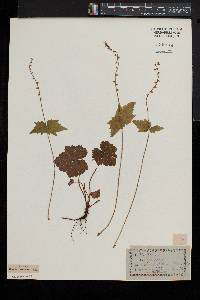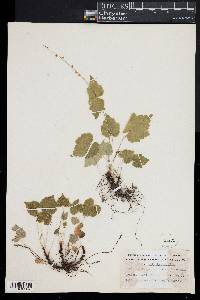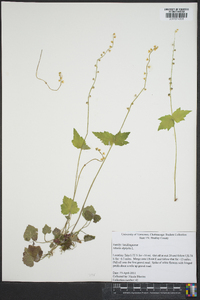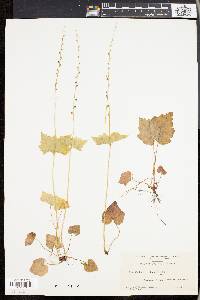Mitella diphylla
|
|
|
|
Family: Saxifragaceae
Two-Leaf Bishop's-Cap, more...two-leaf mitrewort
[Mitella diphylla f. efoliata Farw.] |
Plants not stoloniferous. Flowering stems 10-45(-51) cm. Leaves: petiole 1.8-18 cm, medium and long stipitate-glandular, longer hairs retrorse, white or tan; blade ovate to broadly ovate, n as long as or longer than wide, 1.4-8.5 × 1.4-9.6 cm, margins shallowly to prominently 3- or 5-lobed, crenate or dentate, irregularly to regularly ciliate, apex of terminal lobe acute, rarely obtuse, surfaces subglabrous or sparsely short and long stipitate-glandular; cauline leaves 2, mid cauline or distal, opposite or subopposite, subsessile to short-petiolate, blade (1.1-)1.6-8 × 0.7-6.5 cm. Inflorescences 1-5, remotely or closely 5-22(-27)-flowered, 1 flower per node, not secund, 10-45(-51) cm, sparsely to densely spreading or retrorsely long stipitate-glandular proximally, short stipitate-glandular distally. Pedicels 1-3 mm, short stipitate-glandular. Flowers: hypanthium broadly campanulate, 1-1.6 × 2-3.4 mm; sepals spreading, greenish white or yellowish green, triangular, 1-1.3 × 0.8-1.1 mm; petals white, 9-11(-15)-lobed, 2-4 mm, lobes linear, lateral lobes spreading or ascending; stamens 10, opposite and alternate with sepals; filaments white, 0.2-0.3 mm; anthers 0.1-0.3 × 0.1-0.2 mm; ovary nearly superior; styles divergent, flattened, 0.1-0.2 mm; stigmas unlobed. Seeds dark reddish brown or blackish, 1.2-1.6 mm, nearly smooth. 2n = 14. Flowering Apr-Jun. Rich woods, hardwoods on ravine slopes; 300-2000 m; Ont., Que.; Ala., Ark., Conn., Del., D.C., Ga., Ill., Ind., Iowa, Ky., Md., Mass., Mich., Minn., Miss., Mo., N.H., N.J., N.Y., N.C., Ohio, Pa., S.C., Tenn., Vt., Va., W.Va., Wis. A decoction from whole plants of Mitella diphylla was used by the Iroquois as an emetic, eye medicine, and good-luck charm; seeds were used by the Menominee as sacred items in medicine dances (D. E. Moerman 1998). Mitella intermedia T. A. Bruhin ex Small & Rydberg is a presumed interspecific hybrid between M. diphylla and M. nuda. It has been reported from New York and Wisconsin.
Perennial herb 10 - 45 cm tall Leaves: basal, long-stalked, egg-shaped to rounded with a heart-shaped base, shallowly three- to five-lobed, toothed, slightly hairy above, hairy beneath. Flowers: borne five to twenty on an inflorescence (raceme) 5 - 20 cm long, with 1 - 2 mm individual flower stalks, five white petals 2 mm long and pinnately fringed, and ten stamens. Fruit: a two-beaked capsule splitting open at maturity, containing a few smooth, shiny black seeds 1 - 1.5 mm long. Flowering stem: erect, sparsely hairy near base, glandular-hairy near tip. Each flowering stem has two opposite, more or less stalkless leaves that are smaller than the basal leaves and mostly three-lobed. Similar species: Mitella nuda has up to one leaf on the flowering stem and greenish yellow flowers with petals 3 - 5 mm long. Sullivantia sullivantii, Tiarella cordifolia, Heuchera americana, and Heuchera richardsonii lack fringed petals. Flowering: mid April to late June Habitat and ecology: Locally frequent in mesic or swampy woods, or along shady calcareous and usually rocky slopes. Occurence in the Chicago region: native Etymology: Mitella is the diminutive of the Greek word Mitra, meaning cap, referring to the form of the young fruit. Diphylla means two-leaved, referring to the two leaves of the flowering stems. Author: The Morton Arboretum Stems 1-4 dm, sparsely hairy below, glandular-puberulent above; basal lvs long-petioled, ovate-rotund with cordate base, shallowly 3-5-lobed, crenate, hairy; cauline lvs 2, mostly sessile, smaller, mostly 3-lobed; raceme 5-15 cm; pedicels 1-2 mm; fls white; pet 2 mm, deeply fimbriate-pinnatifid, with obliquely ascending segments; seeds few, black, shining, 1-1.5 mm; 2n=14. Rich woods; Que. to Minn., s. to Va., Ga., and Mo. May, June. An apparent hybrid with M. nuda is M. ةntermedia Bruhin. Gleason, Henry A. & Cronquist, Arthur J. 1991. Manual of vascular plants of northeastern United States and adjacent Canada. lxxv + 910 pp. ©The New York Botanical Garden. All rights reserved. Used by permission. From Flora of Indiana (1940) by Charles C. Deam Infrequent to frequent probably throughout the state although there are no records from the southwestern counties. It is found in moist or wet soil, usually on wooded slopes, especially on the steep slopes of deep ravines, and more rarely in flat woods. .…… Indiana Coefficient of Conservatism: C = 7 Wetland Indicator Status: FACU |
|
|
|

